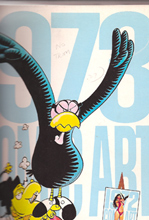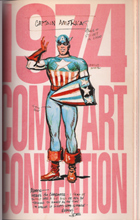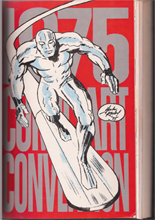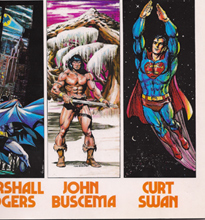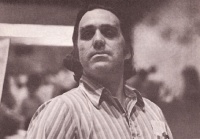
A panel to recall Phil Seuling and his early New York comic conventions, the first conventions with a national draw, was held in conjunction with the 2008 New York Comic Con. ICv2’s Milton Griepp moderated the panel with film producer Michael Uslan; Greg Goldstein, most recently VP-Entertainment at Upper Deck; Diamond’s VP Purchasing Bill Schanes; and DC Comics CEO and Publisher, Paul Levitz. In Part 2, Levitz wraps up the “first convention” recollections, and a discussion is held to properly place the dates of the convention. In Part 3, panelists share their favorite
Paul Levitz:
This is the illustration, my favorite of Phil, from his convention ad. And the copy read, “There are other people who can offer you a selection of comics and posters, but can they offer you arrogance?” That really was the heart of his soul.
Phil was a high school English teacher, passionately energetic about his students and about the language, and in love with comics. There are photos of him showing up with his wife at one of the earliest
Most of what we think of as a comic convention now emerged in his head. The auction—he was the auctioneer himself for most of that time, exhorting people, humiliating people, arguing with people about what they were willing to bid to get that price up to that $40 or maybe a year or two later, $100 for Action #1. He cajoled folks into all of it.
I had started doing a fanzine with my friend Paul Kupperberg as kids, and maybe two months into doing our fanzine, we got a note scribbled back from Phil inviting us to have a free table, a fanzine table at the convention so that people like Greg, who were starting fanzines, Gary Groth, Denis Kitchen, many people whose names are forgotten by anybody but us old fans, would just send bundles of their fanzines and we would sell them, not as a for-profit venture, but just to try to connect people together. And that’s how I started off on the convention committee and then a couple of years later I got drafted into doing the program books for several years, which was a great educational experience. I learned a lot about printing, got yelled at by people like Jim Warren, who knew far more about it and had a quote, unquote “higher standard” for doing these things.
In
Levitz:
Here’s the 73 program book, which was the first one I worked on. I found my printing notes from the program book for the ’73 Con. We printed 5,000 copies. We had had about 3,000 people at the
Here’s Joe Simon’s original drawing from Captain
Bill Schanes:
That was on Phil’s wall in his house for many years.
Levitz:
And my last one, the 1975 book, again at about 10,000 copies.
What Michael was reading about the rooms at the Statler Hilton is actually the secret of why the conventions were born and died. The deal you did that made the convention possible in those days, whether it was Creation Con or New York Con, was a room night deal. You got all the space free in exchange for a certain number of room nights with people actually paying for the rooms. The New York Con was particularly good for that because people like Bill would come in and pack themselves four to a room.
Schanes:
Four? Such luxury. But the bathtub was always good for one person right there, so it was not a problem.
Levitz:
And that would pay for the convention. When that stopped being a viable economic deal because the conventions were too large to fit the available hotel ballrooms that they would give you free for it, and
Milton Griepp:
So when was the last
Levitz:
I think the last one was 1983?
(Discussion with the audience—1983 is decided upon.)
Griepp:
We have programs from '71, '73, '74, '75, '79
Levitz:
I thought the '79 one was an interesting one, kind of sad. Here are three greats of the field who were the Guests of Honor that year, and we’ve just lost all three, including the relatively young Marshall Rogers, who was the hot young talent of the time. Buscema and Swan, who were probably at the peak of their careers on assignments like Conan and Superman…
Schanes:
True professionals.
Levitz:
I did the Curt Swan article for that book, which was why I had a copy fairly handy.
Griepp:
So the first
Uslan:
The first convention was 1964, and I think Phil took over in 1968, if I’m not mistaken.
Levitz:
That sounds about right
Griepp:
What was the period for the monthly events?
Levitz:
'71, I think.
Greg Goldstein:
It’s either very late ’71 or early ’72. If not the first, I was at the second one.
Levitz:
I had a table for all the early ones.
Goldstein:
There are so many people who are still in the business one way or another from those days. I was next to a guy named Jerry Ohlinger who still has his archival shop of movie stills and what have you in
I think he moved his shop recently.
Uslan:
He’s by the the Waverly theater, somewhere around W. 4th., somewhere around there.
Levitz:
The old one down in the basement isn’t there any more.
For Part 3, click here.



